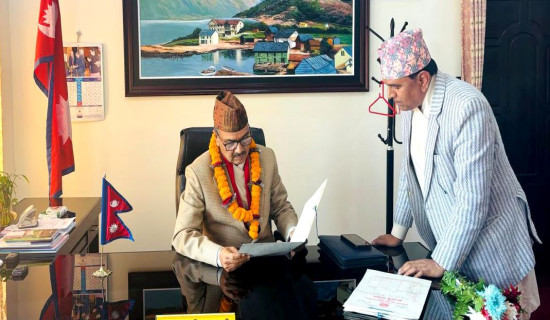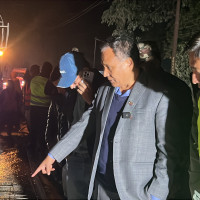- Sunday, 21 December 2025
Breaking Vicious Cycle Of Street Life
As per the statistics of the Child Workers in Nepal Concerned Centre (CWIN), there are 5,000 to 6,000 street children in Nepal. Of them, over 70 per cent are boys. Most of them are concentrated in urban centres like Kathmandu or Pokhara. It is estimated that Kathmandu alone hosts 1,500 to 2,000 street children. According to United Nations sources, there are 150 million street children all over the world. The factors behind a rise in such children are poverty, domestic violence by family members, especially step-parents, death of a parent, alcoholic abuse by family members, family breakdown, conflict, natural calamities, displacement and other factors such as peer pressure or attraction towards the glitter of cities.
The Maoist insurgency displaced many families in rural and other areas, causing family disintegration. This factor is also responsible for a rise in street children in Kathmandu and other cities. Likewise, the 2015 Gorkha earthquake also contributed to a rise in street children by displacing families. In Nepal, children below 16 years of age account for 41 per cent of the total population. In Kathmandu, most street children come from outside the Valley. Street children lack necessities such as food, clothing, shelter, education and healthcare. Since they have limited access to nutritious food, clean drinking water and good sanitation, they are susceptible to diseases. Even sick street children cannot easily get medical treatment.
Harassment
Some street children live on the streets during the day and live with their families at night. Day-time street children tend to loiter around the streets owing to family problems. They may be commercially exploited by their own families for the greed of earning some money. As far as education is concerned, very few street children get access to education. As they are not in a position to attend school, their future is up in the air. That is why when they grow up, they often turn into gangsters or criminals. They are forced to live in a state of fear. They are often harassed at the hands of the police, bullies and other street children. Some street children are forced into begging, while others may be subjected to sexploitation. They may even fall prey to human trafficking.
Street children are compelled to live without a home or family support. They eke out a living as beggars, rag-pickers or scavengers; hawkers of newspapers and food like bread and biscuits; domestic or restaurant workers; porters; construction workers; or transport helpers. Most girls work as domestic or carpet factory workers. Still, they face various problems such as hunger, lack of accommodation and a shortage of clothing. Most street children often develop bad habits. They consume alcohol, use narcotics or use tobacco. They frequently sniff glue, share the same needle for drug injection and engage in promiscuous sex. As such, they are prone to venereal diseases like syphilis and AIDS. Some street children also develop a criminal mindset. They indulge in gang violence and end up being delinquents.
It may be noted that the government once embarked upon a campaign to free Kathmandu of street people and beggars. Under the law, beggars are not allowed to beg in the streets. There is a provision for fining beggars. However, neither the campaign to remove street people nor the provision to remove beggars has been successful. The government should revive the campaign. And the legal provision of barring begging should also be strictly enforced. The government has also initiated a campaign to remove street children by the end of 2082.
Street children are considered the scum of society. They are looked down upon by society. They are called khates, a derogatory term. They are compelled to live with this tag. So even if they want to be rehabilitated back to society and contribute to society as respectable members, it is not an easy proposition. They are compelled to go through physical, psychological, social and even sexual exploitation. They cannot get legal protection. Moreover, they are often deprived of birth registration and citizenship.
The vicious cycle of street life is harrowing for street children. The government should draw up a strategy for eliminating street life. It should see to it that no new children come to occupy the streets, while embarking upon an awareness campaign against street life. The campaign should be targeted at the general public, the families concerned and the children themselves, highlighting the bad consequences and difficulties of street life. Street life is fraught with many risks. Street children may be used by thieves, gangs and rebels. Street children may be used for begging purposes, too.
Enabling environment
The government should, therefore, create an enabling environment for street children to be re-assimilated into society. Those street children who have families should be returned to their families. For those with no homes or families, the government should take it upon itself the responsible for such children. The Sustainable Development Goals have several targets but there are no specific targets relating to street children. But several targets are of relevance to street children in terms of protecting their rights.
The targets relating to eliminating poverty, zero hunger, quality education, decent work and economic growth, reducing inequalities, peace, justice and strong institutions, and partnership for the goals are relevant goals encapsulated in the MDGs. For example, doing away with poverty, one of the major contributory factors to street life, will drastically reduce the number of street children. Many organisations are working for the welfare of street children. Organisations like the CWIN, Save the Children Nepal, Street Child of Nepal and Consortium for Street Children are working for the benefit of children and street children in Nepal. The government should work in collaboration with such organisations to sort out this serious social problem.
(Maharjan has been regularly writing on contemporary issues for this daily since 2000.)










-(1)-original-thumb.jpg)





